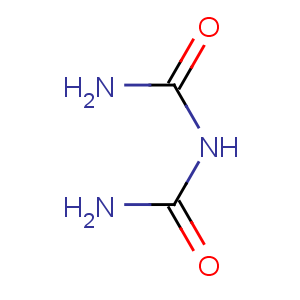Title: Biuret
CAS Registry Number: 108-19-0
CAS Name: Imidodicarbonic diamide
Synonyms: carbamylurea
Molecular Formula: C2H5N3O2
Molecular Weight: 103.08
Percent Composition: C 23.30%, H 4.89%, N 40.76%, O 31.04%
Line Formula: NH2CONHCONH2
Literature References: Prepd on a large scale by the action of heat on urea. Other syntheses are based on the treatment of urea with inorganic halides, such as thionyl chloride, on the interaction of urea and cyanic acid, and on the ammonolysis of allophanic esters and related compds. Has weak bacteriostatic and diuretic properties in rats, also causes a fall in blood pressure, but produces strong irritation of the urinary tract. Increases the activity of pepsin. Comprehensive review and bibliography: Kurzer,
Chem. Rev. 56, 95-197 (1956).
Properties: Hygroscopic, elongated plates from ethanol. d4-5 1.467. When crystallized from water, 5C2H5N3O2.4H2O is formed, which becomes anhydr at 110°, then dec at about 193°. Pyrolysis at higher temps yields melamine. Soly (g/100 g soln) in water at 25° = 2.01; at 50° = 7; at 75° = 20; at 105.5° = 53.5. Freely sol in alc, very slightly sol in ether. Aq solns treated with cupric sulfate and NaOH give a reddish-violet color (biuret reaction, details: Kurzer,
loc. cit., p 181).
Density: d4-5 1.467

